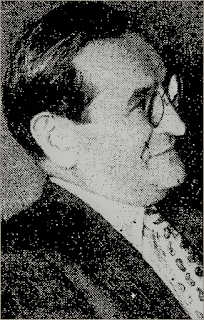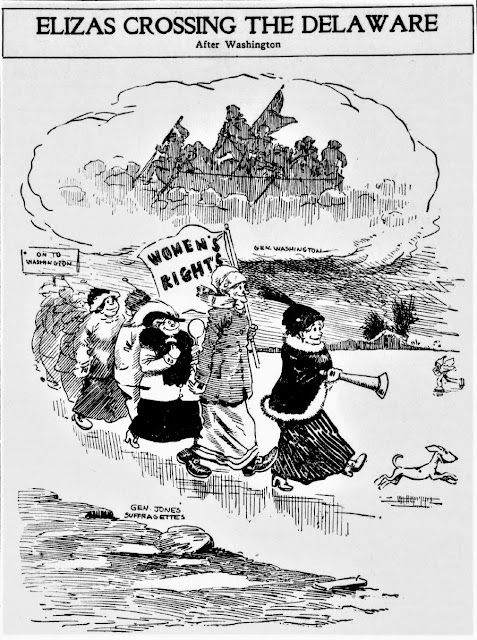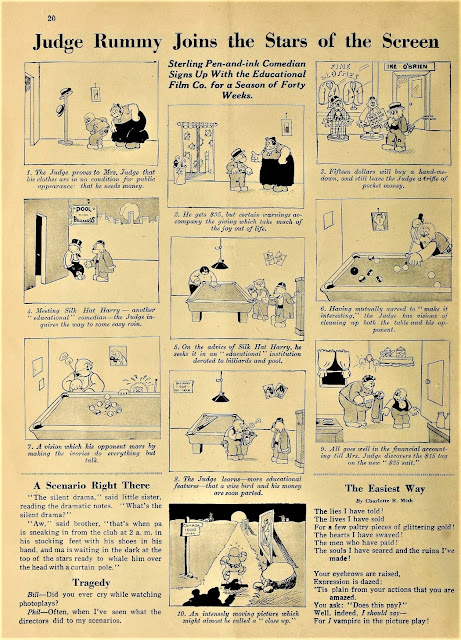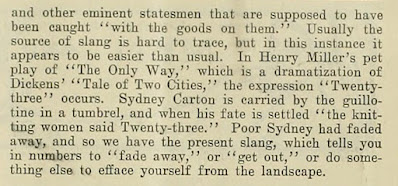THE NIGHT THEY BUMPED OFF HERMAN ROSENTHAL.
by John Adcock
❦
Boardman Robinson, New York Tribune, July 20, 1912
“We take him
to a dago joint down on the east side and let him eat a lot of ravioli and
listen to the wops. He always got a kick out of that… then we take him up to
the McAlpin and set him up in a window on the top floor where he can look
straight up Broadway. He just sits there and looks at the lights and traffic
and talks about the old mob up at Jack’s café.” — Ike Dorgan
about his brother’s last days, to Westbrook Pegler in ‘Death Claims Tad
Dorgan, Phrase Maker’ in the Chicago Tribune, May 3,
1929
THE ROARING FORTIES
The term “roaring forties” designated both a
region and a glamorous era in time specific to New York. Geographically they
started (roughly) at 40th Street and extended northward on Broadway
to 42 Street and on to 50th Street. Damon Runyon recalled
Twenty years ago, the era of the Roaring
Forties was commencing to pass. It had succeeded the era of the Gay Nineties
and the Broadway South of 42nd street. Some of the Gay Nineties
lapped over briefly into the era of the Roaring Forties, as one area always
laps over into another for a spell. Lillian Russell, “Diamond Jim” Brady, the
Hoffman House, Martin’s, Sherry’s, Delmonico’s, Shanley’s and Mouquin’s still
were going concerns and bright memories of Manhattan Island.
The Roaring Forties era brought on the
glamor, that was to become tradition, of the Knickerbocker hotel and Enrico
Caruso and Jack’s restaurant and the Hippodrome and Murray’s, with the
revolving glass dance floor, and the Castle’s and Healy’s and Releenweber’s and
the Follies and Churchill's and Rector’s. It was the era of Wilson Mizner and
Irving Berlin, and George Cohen and of the Harry Thaw trial and the Herman
Rosenthal murder and the old Waldorf. – ‘The Brighter Side of News,’ Damon
Runyon, Times-Union, Oct 3, 1939
THE PRINCE OF REPORTERS
O’Malley was known around town simply as “O’Malley
of the Sun.” Despite the veil of anonymity — the old Sun did not use “by-lines”
— O’Malley became widely known as a reporter and humor columnist. The
brilliance of his style identified him to all who commonly read the paper. O’Malley’s
reign as the prince of reporters began in 1906 and ran on until 1920, when he
resigned to contribute to magazines and publishers.
Frank Ward O’Malley, Tad Dorgan, Hype Igoe, Benjamin
DeCassares, Wilson Mizner, “Spanish” Jack O’Brien (cable editor on the old NY Sun),
Tom Geraghty, Ring Lardner, Damon Runyon, George Luks the cartoonist, Stuffy
Davis, Jim Huneker of the Sun, Vince Barton, and Jack Francis were members,
some regular and some on the periphery, of ‘Jack’s Sporting and Literary
Society’ who met at Jack’s restaurant with its famed Battling Nelson grill
during the Roaring Forties.
That was a year—1912—notable for many things.
So much happened that our great major Broadway sport of all night discussion
and tableside debate hit a new high for all time. For one thing newspaper men
will tell you that 1912 was the greatest year for news in journalistic history,
at least in variety. Early in the year the Titanic went down, one of the very
greatest news stories of all time. Then, just before 2 o’clock the morning of
July 16 gunmen procured by Police Lieut. Charley Becker murdered Herman
Rosenthal thereby beginning a murder yarn that held the front-page attention of
readers for months. – ‘Back on Broadway – Golden Era of Indoor Sports,’ Frank
Ward O’Malley, Buffalo Evening News, Aug 23, 1930.
Hype Igoe, 1938
Hype Igoe was a cartoonist and sporting columnist
on the staff of the San Francisco Examiner. The year following the earthquake
he came to New York and worked on the New York American’s art staff for a few
years, thence to New York Sun as a writer of boxing, later to the Tribune, and finally
a member of the World’s sports staff. Igoe was on the scene of the Rosenthal
killing:
THE NIGHT THEY BUMPED OFF HERMAN ROSENTHAL
‘O’Malley Greatest of All,
Igoe Tells Bill Corum,’ Albany Times-Union, New York, Nov 30, 1932
Dear Bill Corum: When
Frank Ward O’Malley passed on in Paris a few weeks ago, I got me the sinks.
Sad, because Time, greatest of all the line buckers, had taken another of the
disappearing old guard.
I don’t know that you ever
knew him. Not to have been in his company at some time or another in your
newspaper career was to have missed a gentle genius of his kind. Our (Arthur)
Brisbane always called him “the greatest reporter in the world.” Chronicling
was only one of his sidelines. He played at being a human being better than
anyone I had ever met. He wrote with tremendous sweeps of English, yet each
line seemed leavened with the sweet wit which dominated his soul.
For twenty years or more
O’Malley, with Tad (Dorgan), Ben De Casseres, Wilson Mizner, “Spanish” (Jack)
O’Brien, Harry Pollock, Vernie Barton, Corse Payton, Jack Francis, Arnold
Rothstein, Jack Shaughnessy, Freddie Griesheim, and the bold bad boys of “wire
tapping” and “the boats,” made Jack’s eating and drinking shebang our ole
swimmin’ hole. That was before the camel prohibition came.
Herman Rosenthal
Bill, the night they
bumped off Herman Rosenthal! It was maddening in the whirl of its excitement.
Charley Meeghan, the then sports editor of the Morning Telegraph, and myself,
had sauntered into George Considine’s New Metropolis, in 43rd, to
gas and read “copy” on Charley’s printed story of a bout we had just seen in
old Madison Square Garden.
Charley had wired his
story from the ringside and here we were, 20 minutes later, reading it in type
that couldn’t have been cold in the printing.
Charley, who is no more,
Bill, looked up and said “Great age, Hype, great age. The fight isn’t half an
hour old and it–” Charley never finished that sentence.
Bang-bang-, bang, bang,
bang!!!
Five shots, Bill, two
fast, then three.
“Backfire, Charley?’ I
said.
“Backfire, hell,” said our
waiter as he did a standing, sitting dive under the table. Before he
disappeared, he pointed one long great cloud of powder reeking finger at the
big open window. A smoke was floating into the room.
With the five shots came
the piercing voice of Artie Hall, a famous blues singer. She was sitting at a
table with Billy Atwell and Lieutenant File of the police department. From a
rear seat, facing the door, Artie Hall had jumped to her feet and hit high C in
a scream which still rings in my ears.
Miss Artie Hall, June 1900
File, in light civvies,
his back to the door, whirled around, whipped out a long blue service gun and
was through the door like an antelope. They brought him up on charges of negligence
afterwards and Charley and I testified on his behalf. We told how he had gone
“out in the smoke” not knowing what fate had in store for him.
Charley and I ran to the
front door. A figure lay sprawled on the sidewalk, face downward. The fallen
man’s right hand was stretched out full length and between the first two
fingers, standing straight up, there was a half-consumed cigar. A little ribbon
of blue smoke curled upward from it, which through some strange miracle, had
not been disclosed from the man’s fingers as he crashed, stone dead, to the
sidewalk. The maddening whirl in its beginning!
“Herman. It’s Herman,”
whispered big “Judge” Crowley.
“Herman who?” I asked.
And from over my shoulder
came the answer- “Herman Rosenthal, by God!”
I whipped around and there
stood Frank Ward O’Malley. Always the “greatest reporter.” He had beaten Swope
and Hill and the others in from the ole swimmin’ hole. He hadn’t waited for
night editor’s orders. He had started with the first crack of the four gunmen’s
gats. Indeed, a reporter, Bill.
Charles Becker
The strange death watch we
kept in Jack’s that night. Becker was electrocuted for that slaying. O’Malley
had gone up to Sing Sing as our and the old Sun’s representative. As the dawn
came, we, Mizner, Tad, De Casseres, O’Brien, Payton, Barton, (Arnold) Rothstein,
old Jimmy Wakely, Francis, Shaughnessy, (Jack) Dunstan himself, Henry M. T.
Beekman, the great barrister, who coined the famous “old age is the death of
enthusiasm” line, myself and one or two others, sat around a big table with our
watches in the palm of our hands.
Each, in ghastly fashion,
was trying to picture what Becker was doing. What his last moments were like.
Each trembled in the strange excitement of that weird death vigil. Three
minutes to go and it would be 5:30 of the morning, going away time in the big
house in those days.
O’Malley came with the
story. We clung to his Poe-like tale as ivy to an old oak. Bill, you’ll
probably remember that Becker collapsed so pitifully that they asked a Negro
companion in death to “wait on Charley.” Charley’s nerve was gone, Bill, and
the Negro said he’d “sit it out until Charley had it over with.”
Breathlessly we waited for
O’Malley’s return. Mizner got in the first word.
“Well?” he quizzed?
“Bill, the black man
showed the “Czar of the Tenderloin” how to die,” said O’Malley.
“Then why the hell didn’t
you lead off your story with that line?” stormed the exacting Broadway
wit. One of O’Malley’s better lines,
which never got into type until now.
Frank Ward O’Malley! His
lute laid aside for all time, Bill. I can see him now, black silk cords hanging
from his nose glasses, handsome, kindly, sweet singer of prose! He was the only
great reporter of my time who never talked of himself. I often wonder if Frank
Ward O’Malley ever knew Frank Ward O’Malley.
Odd thing, Bill, they
never put him on a big fight story. How he could have garnished the tragedy of
the crushing of the Orchid Man at Boyle’s Thirty Acres or the malleting of the
ox-like Willard at Toledo! A reporter!!
Hype Igoe.
Lt. Charles
E. Becker, a brutal cop on the take, was convicted of
Rosenthal’s murder and electrocuted on July 13, 1915, at Sing Sing prison.
THE BRAIN
Power of the Press, even when the Power was
only half a horse. Arnold Rothstein, who came into Jack’s every morning, was
one of the most delightful beer companions with whom I have ever sat out a
session. He impressed me as being a great executive who simply took the easiest
way in a country where craft and graft are all ye need to know. – ‘Jack’s,’ Benjamin
De Cassares, American Mercury, Nov 1932
The man who ran the gambling parlor on the second floor of the Metropole at the
time of Rosenthal's demise was the gambler Arnold Rothstein. He took over where Rosenthal left off,
soon running New York’s drug and gambling rackets. His fate was the same, shot
in the abdomen outside the Park Central Hotel on Nov 4, 1928. Rothstein was one
of the peripheral members of ‘Jack’s Sporting and Literary Society.’ In a ‘Hollywood
Day by Day’ column in New Movie Magazine, by NEMO (O. O. McIntyre), the
author wrote.
I had dinner with Jack the other night and he
told me what I didn’t know before: that Arnold Rothstein, the murdered gambler,
used to join that famous restaurant round table, and that no one around the
board had a more razor-like wit.
Damon Runyon called him “The Brain.” Runyon
recalled “He was the villain in a Fitzgerald novel. He carried on where Becker
left off after Rosenthal’s murder; introduced the modern gangster; served crime
as pay off man; taught politician and crook how to work profitably together.”
Arnold Rothstein, financier of the New York
Underworld – Lindy’s restaurant on Broadway was his favorite hangout, and it
was from there that a telephone call summoned him to his death. Frequently he
sat all night in Lindy’s. drinking cup after cup of coffee and swapping gossip
and wisecracks with such figures as Damon Runyon, the reporter; T.A. “Tad”
Dorgan, the cartoonist; Jack Lait, Con Conrad, and Harry Hershfield. – ‘The
Murder of Rothstein,’ Chicago Tribune, April 28, 1940
––To
be Continued––
Miss Artie Hall, 1903
Artie Hall was a white "coon-shouter" from Georgia who first appeared on the stage in 1899. She mixed her own brown make-up and at the end of her act she would lower her blouse to show the white skin beneath the cloth. Newspapers hectored her for showing too much torso at the reveal, and for showing her underwear while dancing. By 1912 language had changed, and she was now known as a "blues-singer."
❦



.png)



(1)(1).png)
(1).png)






.JPG)
.JPG)
.JPG)





















